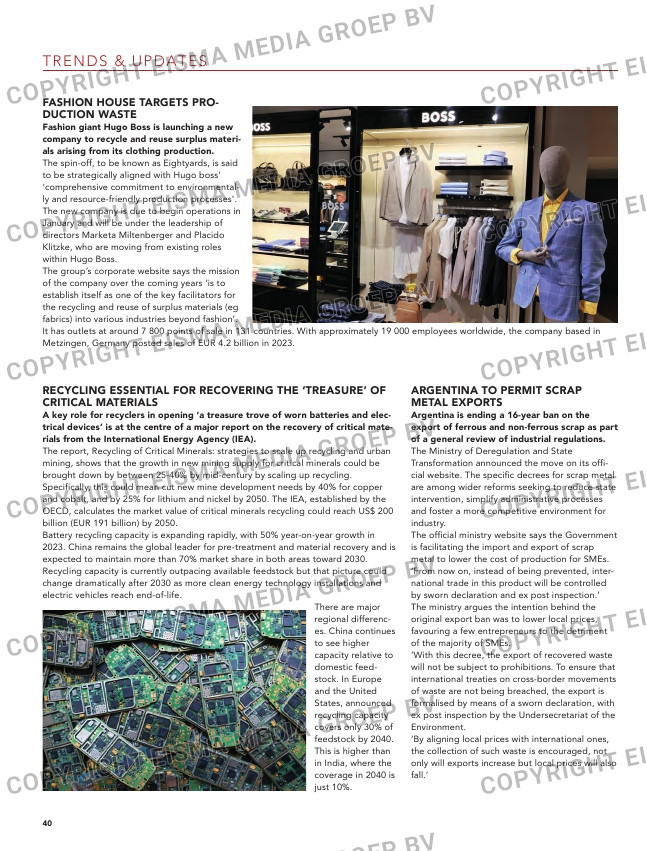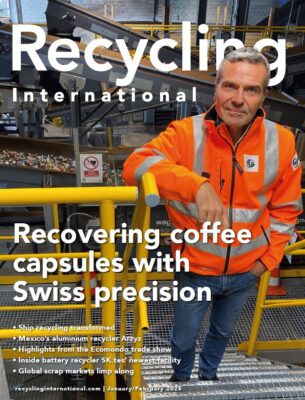Page 40 from: Recycling International Jan/Feb 2025

40
FASHION HOUSE TARGETS PRO-
DUCTION WASTE
Fashion giant Hugo Boss is launching a new
company to recycle and reuse surplus materi-
als arising from its clothing production.
The spin-off, to be known as Eightyards, is said
to be strategically aligned with Hugo boss’
‘comprehensive commitment to environmental-
ly and resource-friendly production processes’.
The new company is due to begin operations in
January and will be under the leadership of
directors Marketa Miltenberger and Placido
Klitzke, who are moving from existing roles
within Hugo Boss.
The group’s corporate website says the mission
of the company over the coming years ‘is to
establish itself as one of the key facilitators for
the recycling and reuse of surplus materials (eg
fabrics) into various industries beyond fashion’.
It has outlets at around 7 800 points of sale in 131 countries. With approximately 19 000 employees worldwide, the company based in
Metzingen, Germany posted sales of EUR 4.2 billion in 2023.
RECYCLING ESSENTIAL FOR RECOVERING THE ‘TREASURE’ OF
CRITICAL MATERIALS
A key role for recyclers in opening ‘a treasure trove of worn batteries and elec-
trical devices’ is at the centre of a major report on the recovery of critical mate-
rials from the International Energy Agency (IEA).
The report, Recycling of Critical Minerals: strategies to scale up recycling and urban
mining, shows that the growth in new mining supply for critical minerals could be
brought down by between 25-40% by mid-century by scaling up recycling.
Specifically, this could mean cut new mine development needs by 40% for copper
and cobalt, and by 25% for lithium and nickel by 2050. The IEA, established by the
OECD, calculates the market value of critical minerals recycling could reach US$ 200
billion (EUR 191 billion) by 2050.
Battery recycling capacity is expanding rapidly, with 50% year-on-year growth in
2023. China remains the global leader for pre-treatment and material recovery and is
expected to maintain more than 70% market share in both areas toward 2030.
Recycling capacity is currently outpacing available feedstock but that picture could
change dramatically after 2030 as more clean energy technology installations and
electric vehicles reach end-of-life.
There are major
regional differenc-
es. China continues
to see higher
capacity relative to
domestic feed-
stock. In Europe
and the United
States, announced
recycling capacity
covers only 30% of
feedstock by 2040.
This is higher than
in India, where the
coverage in 2040 is
just 10%.
TRENDS & UPDATES
ARGENTINA TO PERMIT SCRAP
METAL EXPORTS
Argentina is ending a 16-year ban on the
export of ferrous and non-ferrous scrap as part
of a general review of industrial regulations.
The Ministry of Deregulation and State
Transformation announced the move on its offi-
cial website. The specific decrees for scrap metal
are among wider reforms seeking to reduce state
intervention, simplify administrative processes
and foster a more competitive environment for
industry.
The official ministry website says the Government
is facilitating the import and export of scrap
metal to lower the cost of production for SMEs.
‘From now on, instead of being prevented, inter-
national trade in this product will be controlled
by sworn declaration and ex post inspection.’
The ministry argues the intention behind the
original export ban was to lower local prices,
favouring a few entrepreneurs to the detriment
of the majority of SMEs.
‘With this decree, the export of recovered waste
will not be subject to prohibitions. To ensure that
international treaties on cross-border movements
of waste are not being breached, the export is
formalised by means of a sworn declaration, with
ex post inspection by the Undersecretariat of the
Environment.
‘By aligning local prices with international ones,
the collection of such waste is encouraged, not
only will exports increase but local prices will also
fall.’
36-37-38-39-40_trendsupdates214paginaadv.indd 40 29-01-2025 16:29



